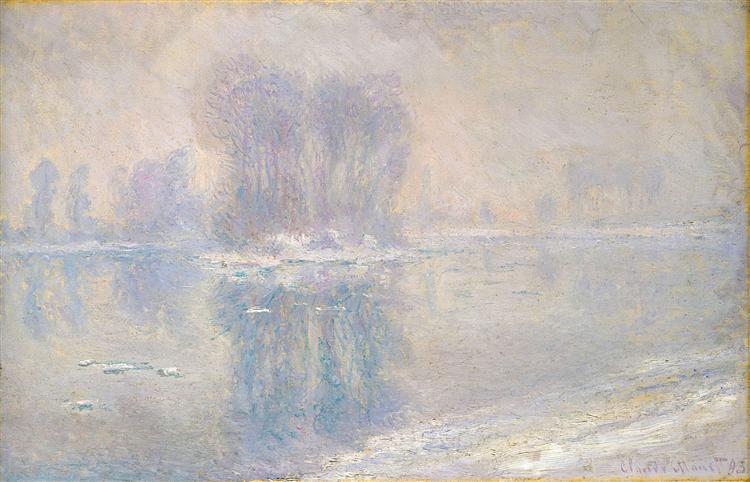Beschreibung
Das Gemälde "Ice in the Seine in Bennecourt" von Claude Monet, das 1897 hergestellt wurde, ist ein Meisterwerk des Impressionismus, eine künstlerische Bewegung, die Monet bei der Definition und Förderung beigetragen hat. Diese Arbeit erfasst nicht nur einen bestimmten Moment im Laufe der Zeit, sondern zeigt auch die Fähigkeit des Künstlers, Licht und Atmosphäre in kühne Pinselstriche und eine lebendige Palette zu übersetzen. Monet, spezialisiert auf Malerei im Freien, übersetzt die Fragilität des Winters in der Landschaft von Sena, wo das vorherrschende Eis sowohl die Stille als auch die Schließung der Saison hindeutet.
Die Zusammensetzung der Arbeit konzentriert sich auf den Sena -Fluss, der sich während der Überquerung der Landschaft windet, umgeben von nackten Bäumen und einem Himmel, in dem das Wintersonnenlicht angedeutet wird. Die Anordnung der Elemente innerhalb der Arbeit ist akribisch; Das Eis erstreckt sich über das Wasser in einem Texturspiel, bei dem die Schatten und Reflexe zart verflochten sind. Monet verwendet eine lose Pinselstrich -Technik, die die Essenz von Eis und Wasser befürchtet, was Bewegung und Leben in einem Szenario hindeutet, das als statisch interpretiert werden könnte.
Besonders bemerkenswert ist die Verwendung von Farbe in "ICE in Sena in BenneCourt". Monet kombiniert Blau-, Grau- und Weißtöne, um die Kälte des Winters hervorzurufen, während wärmere Nuancen auf Sonnenlicht rufen. Diese chromatische Wahl erhöht nicht nur das Gefühl der Kälte, sondern bietet auch ein harmonisches Gleichgewicht in der Zusammensetzung. Die Eisbereichen leuchten mit subtilen Reflexionen, die Wellen im Wasser vermitteln ein Gefühl der Tiefe, und die Serena -Palette wird durch die subtilen Bürstenstriche betont, die die umgebende Landschaft abgrenzen.
Was die Charaktere betrifft, so werden ätherische Figuren wahrgenommen, die ohne definierte Details nicht zu sehen sind, wodurch sich der Betrachter in die Atmosphäre der Szene eintaucht, anstatt sich auf die Erzählung zu konzentrieren. Diese Zahlen könnten als Einheimische interpretiert werden, vielleicht als Fischer oder Wanderer, die in die Landschaft als integrale Teile einer Umgebung eingeführt werden, die sowohl in ihren visuellen als auch in emotionalen Aspekten präsentiert wird. Diese vage gezogenen Silhouetten fördern die Idee, dass Natur und Mensch untrennbar sind und in einem subtilen Tanz wirken, der die Wintererfahrung definiert.
Claude Monet, geboren 1840 und starb 1926, war ein Pionier des Impressionismus, der für seinen innovativen Ansatz an Licht und Farbe bekannt war. Seine Arbeit dreht sich oft um Themen der Natur und seine Wahrnehmung in verschiedenen Momenten des Tages und in den Stationen. "Ice in Sena in Bennecourt" ist eines der vielen Werke, in denen Monet den Seine River, ein wiederkehrendes Thema in seiner Sammlung, erkundete. Dieser sich wiederholende Ansatz ermöglicht eine intensive Untersuchung von Licht und Farbe und erleichtert einen konstanten Dialog zwischen Prinzip und Final, Natur und Zeitlichkeit.
Dieses Gemälde erinnert an den Kontext von Monets Arbeit und seinen Fokus auf die Beziehung zwischen dem menschlichen und seiner Umgebung. Während seiner gesamten Karriere traten Monet weiter in seiner Technik mit Werken wie "Impression, Rising Sun", bei denen die Prinzipien des Impressionismus definiert werden. "Ice in Sena in Benncourt" ist in diese Tradition eingeschrieben und erinnert an Monets Erfüllung mit der Vergleich der Natur und der Art und Weise, wie es seine Wahrnehmung durch Malerei darstellt. In seiner Beziehung zur Landschaft und ihrer Darstellung ist dieses Werk ein Zeugnis der komplexen Gefühle, die die Übergänge zwischen den Stationen bewohnen und wie Licht die Anerkennung des Alltags in künstlerische Erfahrung verwandelt.
KUADROS ©, eine berühmte Farbe an Ihrer Wand.
Handgefertigte Ölgemälde, mit der Qualität professioneller Künstler und dem unverwechselbaren Siegel von KUADROS ©.
Pictures Reproduction Service mit Zufriedenheitsgarantie. Wenn Sie mit der Nachbildung Ihres Gemäldes nicht vollständig zufrieden sind, erstatten wir Ihr Geld zu 100%.

